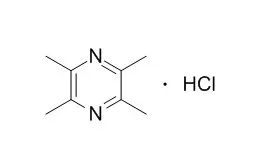| In vitro: |
| Chinese Journal of Immunology, 2009, 25(5):413-6. | | Study on the down-regulatory effects of Ligustrazine Hydrochloride on tumor-induced immunosuppression by Colon26 tumor cells in vitro[Reference: WebLink] | To study the regulatory effects of Ligustrazine Hydrochloride(LHC)on tumor-induced immunosuppression by Colon26 cells in vitro.
METHODS AND RESULTS:
Colon26 cells were cultured for 48 h in the presense of LHC and either the cell fraction or the cultural supernatants was collected,with the untreated Colon26 cells as control for the study.The down-regulating effects of LHC on tumor immunosuppressions (including the suppressed NK killing and ConA induced transformation of murine spleen cells detected by MTT,and the reduced expression levels of IL-2Rα,CD3ε+ζ+ and CD3ε-ζ+ detected by FCM) were determined.The concentrations of immunosuppressive cytokines,including TGF-β1,VEGF,IL-4,IL-6 and IL-10,in the supernatants were analyzed by quantitative ELISA.The relationship among the down-regulatory effects of LHC on secretion immunosuppressive cytokines and tumor immunosuppressions were evaluated by multiple linear regression analysis.All of the cytokines assayed were found in the supernatant of Colon26 treated without LHC,in which TGF-β1 was the highest,and the significant inhibition of five immune functions mentioned above was showed.To the Colon26 treated by LHC,the concentrations of TGF-β1,IL-6 and IL-10 in the first re-cultured supernatant and its inhibition of five immunol functions decreased greatly.The concentrations of TGF-β1 and IL-6 in the second re-cultured supernatant and its inhibitions of transformation,CD3+ζ+ and CD3-ζ+resumed highly.The positive correlations existed between TGF-β1 and inhibition of immunol functions except for transformation,between IL-6 and inhibition of transformation or CD3-ζ+,between IL-10 and inhibition of NK killing or IL-2Rα or CD3+ζ+,respectively.
CONCLUSIONS:
LHC can exert down-regulate effects on Colon26 secretion of immunosuppressors and its tumor immunosuppression.Reducing tumor immunosuppression of Colon26 through decreasing its secretion of immunosuppressors should be one of anti-tumor mechanisms of LHC. |
|
| In vivo: |
| Zhongguo Zhong Xi Yi Jie He Za Zhi. 2014 May;34(5):531-5. | | [Effect of ligustrazine hydrochloride on coagulation reaction and inflammation reaction in single valve replacement patients with rheumatic heart disease undergoing cardiopulmonary bypass].[Pubmed: 24941838] | To observe the protection effect of Ligustrazine Hydrochloride (LH) on coagulation reaction and inflammation reaction in single valve replacement patients with rheumatic heart disease undergoing cardiopulmonary bypass (CPB).
METHODS AND RESULTS:
Totally 40 patients undergoing single valve replacement were recruited in the study and randomly assigned to the two groups, the treatment group and the control group, 20 in each group. In treatment group LH (3 mg/kg) was intravenously infused from the jugular vein. LH (3 mg/kg) was also added in the CPB priming. In the control group LH was replaced by equal amount of normal saline. Endothelial micro-particles (EMP) count was detected before CPB, 30 min after CPB, 1 h and 24 h after CPB finished. The coagulation reaction time (R), coagulation time (K), clotting formation velocity (alpha angle), maximum amplitude (MA), coagulation index (CI), platelet (PLT), hypersensitive C reactive protein (hs-CRP), IL-6, and IL-10 were detected before CPB, 1 h and 24 h after CPB finished.
There was no statistical difference in aorta arresting time, period of CPB, post-operative drainage volume, plasma transfusion volume, post-operative respirator assistant time, and hospitalization time between the two groups (P >0.05). Compared with pre-CPB in the same group, the count of EMP was much higher at 30 min after CPB and 1 h after CPB finished (P < 0.01). R and K, hs-CRP, IL-6, and IL-10 increased at 1 h and 24 h after CPB finished (P <0.01,P < 0.05). The alpha angle,.MA, CI, and PLT decreased 1 h after CPB finished (P <0.01). The a angle increased, while CI and PLT decreased 24 h after CPB finished (P <0.05). Compared with the control group in the same period, the count of EMP was lower in the treatment group 30 min after CPB and 1 h after CPB finished (P <0. 05, P <0. 01). R and K values obviously decreased in treatment group 1 hour after CPB finished (P <0. 05), while a angle, MA, CI, and PLT increased (P <0. 05, P <0. 01). hs-CRP and IL-6 decreased in the treatment group 1 h and 24 h after CPB finished (P <0.05), while IL-10 increased (P <0.05). The count of PLT increased 24 h after CPB finished in the treatment group (P <0. 05).
CONCLUSIONS:
LH had certain protection effect on the vascular endothelium undergoing CPB, and lower excessive activation of coagulation reaction and inflammation reaction in patients undergoing CPB. | | Chinese Journal of Nervous & Mental Diseases, 1994,20(3):151-4. | | Effect of ligustrazine hydrochloride on the concentration of TXB2 and 6-Keto-PGF1a of the plasma and ventricular cerebrospinal fluid and intracranial pressure in severe brain injured patients.[Reference: WebLink] |
METHODS AND RESULTS:
Twenty-eighht cases of brain injured patients were divided into two groups: treated with or with- out Ligustrazine Hydrochloride respectively. The concentration of TXBi and 6KP in plasma and V CSF were analysed with RIA before and 3 hours after the treatment, and ICP were also recorded at the same time. The result showed: before the treatment, the concentration of TXB2 and 6KP in plasma and VCSF in both groups were significantly higher than that of the controlled group, Ligustrazine Hydrochloride could reduce the concentration of TXB2 in plasma and VCSF and had no significant influence on ICP.
CONCLUSIONS:
These results suggest that Ligustrazine Hydrochloride can inhibit the activation of humai platelet following severe brain injury , improve t'ie balance, of TXA2 - PGI2 within the circulatory blood. It also implies that Ligustrazine Hydrochloride might be used as one of the agents to treat brain injury. |
|






 Cell. 2018 Jan 11;172(1-2):249-261.e12. doi: 10.1016/j.cell.2017.12.019.IF=36.216(2019)
Cell. 2018 Jan 11;172(1-2):249-261.e12. doi: 10.1016/j.cell.2017.12.019.IF=36.216(2019) Cell Metab. 2020 Mar 3;31(3):534-548.e5. doi: 10.1016/j.cmet.2020.01.002.IF=22.415(2019)
Cell Metab. 2020 Mar 3;31(3):534-548.e5. doi: 10.1016/j.cmet.2020.01.002.IF=22.415(2019) Mol Cell. 2017 Nov 16;68(4):673-685.e6. doi: 10.1016/j.molcel.2017.10.022.IF=14.548(2019)
Mol Cell. 2017 Nov 16;68(4):673-685.e6. doi: 10.1016/j.molcel.2017.10.022.IF=14.548(2019)